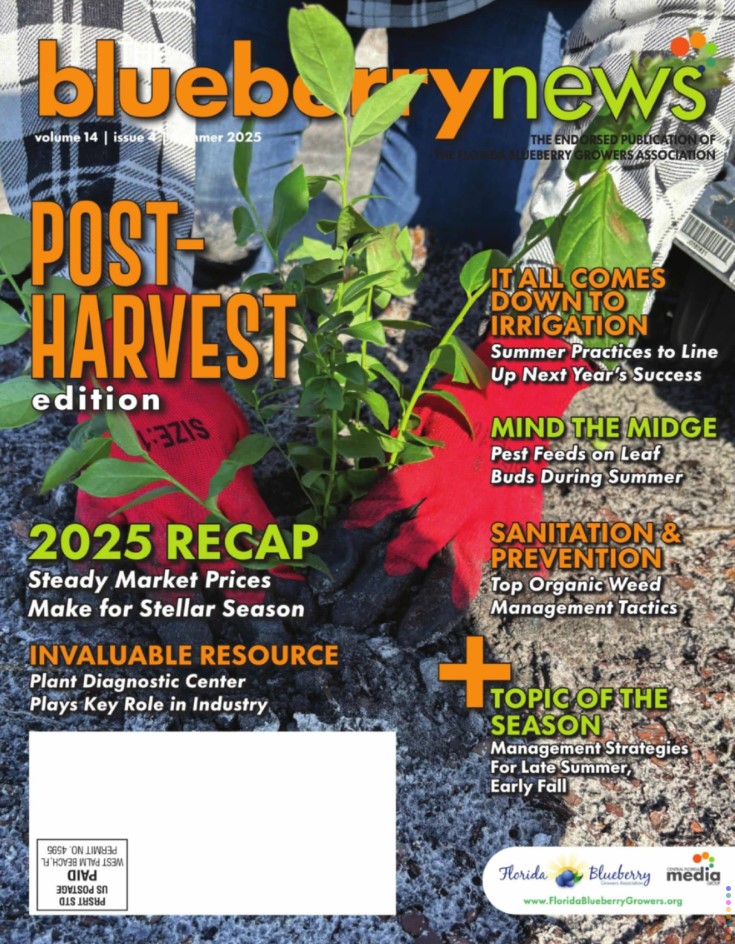Not All Cultivars Respond Well to Hydrogen Cyanamide
Chill hour accumulation is important for timely and vigorous spring growth in southern highbush blueberry (SHB). Some SHB cultivars exhibit slow or delayed leaf growth and canopy development during emergence from dormancy if grown in low-chill areas under the deciduous production system. Delayed leaf canopy development can result in slower fruit ripening, reduced fruit quality, and plant stress, especially for plants that set a moderate to heavy crop. Hydrogen cyanamide (HC), trade names Dormex™ and BudPro®, is a plant growth regulator that may be a useful tool for stimulating earlier and stronger spring leafing of certain SHB cultivars grown under the deciduous production system in Florida or in other low-chill areas. Where spring leafing is significantly advanced by HC, the harvest season is often earlier and more concentrated than would otherwise occur. Increased berry weight (size) and a slight increase in total yield have also been noted in some cases, but the main advantages are earlier and more concentrated berry harvests.
Hydrogen cyanamide is classified as a restricted-use pesticide with specific requirements for its safe and legal application. These include specific requirements for protective gear, and specialized loading and spraying equipment (e.g., an enclosed tractor cab). Growers who are interested in using HC but lack specialized equipment, applicators license, or expertise for its effective, safe, and legal application, may want to consider custom application options. Hydrogen cyanamide should be kept under cool conditions, not to exceed 68°F and not stored in direct sunlight. New HC should be purchased each year rather than using leftover HC from the previous year. Orders are typically placed in the fall, allowing time for shipment to the southeastern United States. Considering the current supply chain issues, it is advisable to place orders as early as possible to ensure timely delivery.
Not all blueberry cultivars grown in Florida need or respond well to HC treatment and some cultivars are susceptible to injury (spray burn) from HC. SHB cultivars “Emerald,” “Farthing,” and “Patercia” have been grown successfully using HC in areas of North and North Central Florida where plants are exposed to enough cool weather to enter dormancy and receive some chilling. Recent research with “Optimus” suggests that its flower buds are sensitive to HC and significant flower bud thinning may occur. In “Optimus,” some advancement in fruit harvest was observed, likely due to flower bud thinning with what appeared to be a reduction in total yield. No or very low doses of HC are suggested for “Optimus” with the understanding that significant flower bud thinning and associated yield reduction are likely to accompany any advancement in harvest date. “Colossus,” which typically sets fewer flower buds than other cultivars and ripens early in the season, does not currently appear to be a strong candidate for HC. Preliminary tests suggest that “Sentinel” does not benefit from HC sprays in North Central Florida. Suggested use of HC on newer cultivars may change with additional experience, observations, and research. Since cultivars vary in their response and sensitivity to injury, use HC as a small-scale test on cultivars with unknown response to hydrogen cyanamide.
Many variables come into play for a successful HC response. In addition to cultivar specificity, plant condition, and environmental conditions prior to, during, and immediately after treatment are believed to affect the response to HC. Plants should be completely dormant prior to treatment and have received some natural chilling. HC application is not advisable for evergreen blueberry production. For deciduous blueberry production, the exact threshold of pre-chilling needed is not known and likely varies among cultivars. Generally, under Florida conditions, the more chilling that occurs prior to HC application, the better the response on cultivars that are otherwise good candidates for HC. However, HC applications should be made 30 or more days prior to natural flower and vegetative bud break and before a significant percentage of the flower buds have passed developmental stage 2 (flower buds swelling but bud scales still closed. For illustrations of flower bud development stages, see EDIS pub. 2022 Florida Blueberry Integrated Pest Management Guide HS1156 https://edis.ifas.ufl.edu/pdf/HS/HS380/HS380-Dnt92580jc.pdf.
Since application is based on anticipated bud break and flower bud development, the timing may vary with location and year, but HC is typically applied in north-central Florida between mid-December and early January. Hydrogen cyanamide may interact with oil sprays and sprays containing copper or oil and copper. Refer to product labels for information on timing sprays to avoid negative interactions. Additional information on the use of HC in southern highbush blueberries can be found in the Florida Blueberry Integrated Pest Management Guide HS1156 https://edis.ifas.ufl.edu/pdf/HS/HS380/HS380-Dnt92580jc.pdf.
Remember to always refer to and read the pesticide label before making any application. The pesticide label supersedes any information contained in this article, and it is the legal document referenced for application standards.
CREDIT:
Jeff Williamson and Gerardo Nunez, Horticultural Sciences Department, IFAS, University of Florida





